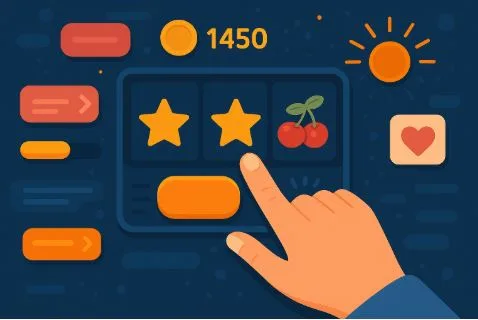The dopamine loop: how digital platforms train us without us knowing
Open your phone. Scroll through your feed. See a bright notification bubble pop up. Your pulse quickens for just a moment—was it a like, a message, a win, a deal? That tiny rush is no accident. It’s part of a carefully designed system that knows how to keep you coming back. The dopamine loop is one of the most effective behavioral patterns in the digital age, and it works quietly in the background, training our habits with a precision that feels invisible.
In neuroscience, dopamine is often linked to pleasure, but it’s more accurately a chemical messenger of anticipation. It’s what makes you check your phone “just in case,” what urges you to refresh a page for new updates, what pushes you to try “one more” in a game. Platforms — from social media networks to gaming environments – capitalize on this, crafting experiences that create a steady rhythm of tiny rewards. The result? Users stay engaged, sometimes far longer than they intended.
The architecture of anticipation
The dopamine loop works because it blends two elements: unpredictability and reward. Predictable rewards are pleasant, but they don’t grip the brain in the same way. When you don’t know if the next scroll, click, or spin will deliver something satisfying, your attention sharpens. This is the essence of a variable reward schedule, the same principle that makes people keep watching the next episode, pull a slot lever, or refresh their inbox.
Platforms that excel at engagement know how to make this unpredictability feel exciting rather than frustrating. Slot Gacor, for instance, integrates a balance of consistent wins with rare, thrilling surprises, ensuring that anticipation stays high while the experience remains enjoyable. The blend of steady rewards and the possibility of something extraordinary creates a rhythm that feels both motivating and entertaining.
Digital spaces often amplify this effect with design choices that heighten expectation—occasional bursts of activity, sudden visual cues, or celebratory sequences when something rare happens. The power lies in the uncertainty, because maybe the next interaction will be the most rewarding yet.
Micro-interactions as habit builders
It’s not just the big wins that keep people hooked. Micro-interactions—those small, instant feedback moments—play a huge role in forming habits. The slight bounce of a button, the glow around a reward, or the chime that plays when you achieve a milestone all serve as reinforcement. These details seem harmless, but over time, they become part of a conditioned loop: action, feedback, anticipation, repeat.
Even color plays a role here. Red for urgency, green for approval, gold for reward—these signals tap into universal associations. They act as signposts in the experience, guiding behavior without the need for explicit instruction. Platforms know that when these cues are consistent, they build familiarity, and familiarity leads to trust and repetition.
Layering rewards for deeper engagement
One reward is good. Multiple layered rewards are better. In many digital experiences, the dopamine loop is strengthened by stacking different kinds of reinforcement. Completing a task might not only give you points but also unlock a visual badge, push you up a leaderboard, and trigger a satisfying animation.
By blending tangible and intangible rewards, platforms increase the emotional value of an interaction. The user feels accomplished, recognized, and entertained all at once. It’s not about the single win—it’s about building a rhythm of rewards that feels both earned and delightful.
This approach works across different contexts. A shopping app might send a discount after a purchase, then a follow-up message showing how much you saved. A fitness tracker might celebrate a workout with a badge, a streak count, and a comparison to your previous best. Each layer is a nudge to keep going.
The role of scarcity and time pressure
Scarcity and urgency amplify the dopamine loop by adding stakes. Limited-time offers, countdown timers, or seasonal events push users to act before the opportunity disappears. Even if the reward is digital and infinite in reality, presenting it as scarce makes it feel more valuable.
This is why some games launch special features for a brief period, or why apps introduce “exclusive” rewards for completing a task within a certain window. The combination of anticipation, scarcity, and a clear path to success makes it hard to resist engaging again—and again.
Social validation as fuel
While dopamine can be triggered by purely individual experiences, adding a social layer intensifies the loop. Seeing others succeed, earn rewards, or react to your achievements creates a powerful feedback cycle. Social platforms have mastered this by integrating likes, comments, shares, and public leaderboards into their core design.
In gaming communities, celebrating a player’s achievement in a visible way encourages others to seek the same recognition. It turns personal wins into community events, making the reward feel bigger and the anticipation sharper.
The mid-loop anchor
Halfway through an interaction, platforms often insert an “anchor” that keeps you engaged. This could be a progress bar showing you’re 80% toward a goal, a hint of an upcoming feature, or a teaser for a possible win. It’s a way to keep the dopamine loop primed, ensuring you don’t abandon the experience before reaching the reward.
In some environments, like Slot88, these anchors can be subtle but effective—showing near-misses that make you feel you were “almost” rewarded, or offering a quick retry option to keep momentum. This taps into the human tendency to avoid leaving something unfinished, even if finishing it offers no guaranteed outcome.
Why the loop is hard to resist
The dopamine loop taps into basic survival mechanisms. Our brains are wired to seek novelty, to be alert for potential rewards, and to repeat actions that feel beneficial. In prehistoric times, this helped humans find food, identify threats, and build social bonds. In the digital age, those same instincts are triggered by notifications, streak counts, and rare event drops.
The loop works best when it stays just below the level of conscious awareness. If users felt they were being manipulated, they might resist. But when the reinforcement feels organic—part of the natural flow of interaction—it becomes easy to justify. “I’m just checking,” turns into minutes or hours of engagement.
Responsible use of the dopamine loop
While this behavioral design is powerful, it carries ethical weight. The same techniques that keep users engaged can also lead to compulsive use. Responsible platforms set boundaries—introducing natural stopping points, offering transparency about reward mechanics, and encouraging healthy breaks.
Some platforms have found that user trust grows when they prioritize balance. By using the dopamine loop to enhance enjoyment without overwhelming it, they can create long-term loyalty rather than short-term overuse.
The future of behavioral design
As technology evolves, the dopamine loop will adapt. With AI, AR, and more personalized data, rewards can become hyper-tailored to individual preferences. Instead of one-size-fits-all triggers, platforms can learn exactly which cues spark anticipation for each user and deliver them with precision.
This customization has the potential to make interactions feel deeply personal and satisfying—but it also raises the stakes for ethical design. When every interaction can be tuned to maximize engagement, the line between entertainment and compulsion becomes thinner.
A quiet trainer in our pocket
The dopamine loop is not inherently good or bad—it’s a mechanism. What matters is how it’s used. At its best, it can encourage learning, build positive habits, and make experiences more rewarding. At its worst, it can trap attention in cycles that are hard to break.
Every time a platform lights up your screen with a reward, it’s reinforcing a behavior. Every sound effect, animation, or progress update is part of a training program you didn’t sign up for but willingly participate in. The loops hum quietly in the background, shaping the way you interact with technology.
They don’t need permission to work. They just need your attention. And once they have it, they know exactly how to keep it.





